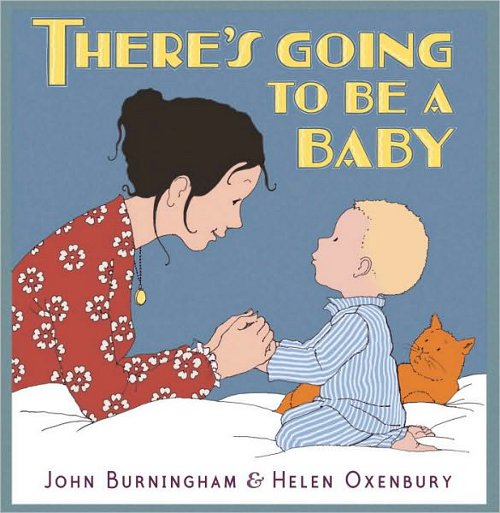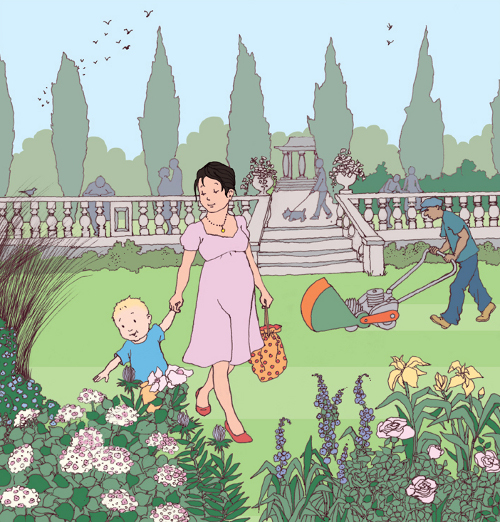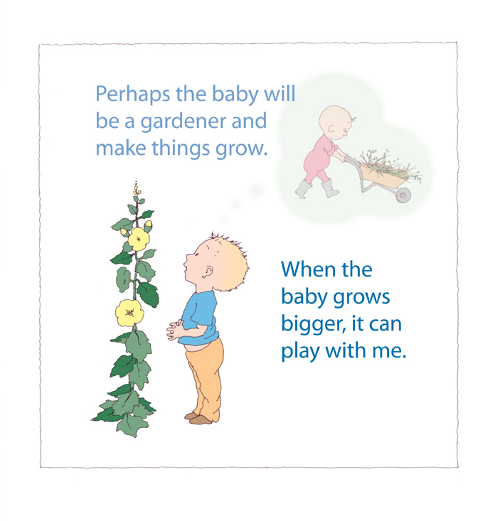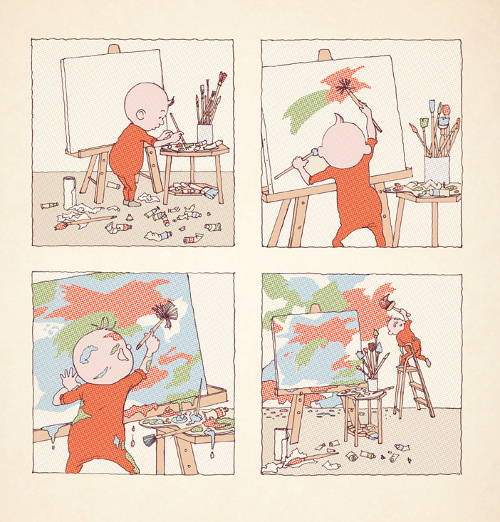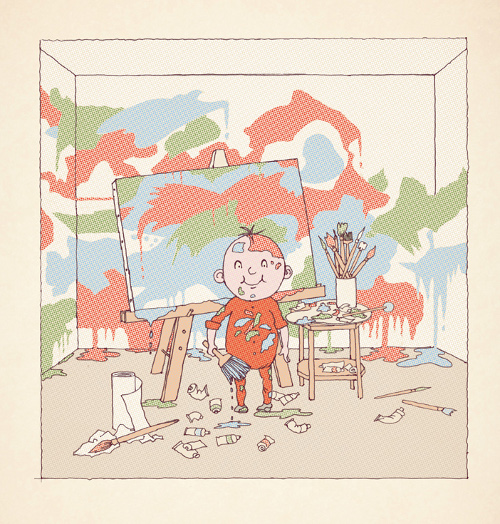One Dreamy Author & Illustrator Pairing
By Jules
And now we come to that odd time of year, blogging-wise, when I won't necessarily be talking about 2011 titles. I will soon. Fear not. But I'm still not done with some 2010 stragglers I wanted to mention. And There's Going to Be a Baby(Candlewick, September 2010)—the story of a young boy trying to adjust to his sibling's impending arrival by imagining possibilities for the baby's future with his mother, written by John Burningham and illustrated by Helen Oxenbury—is one of them.
I may have mentioned a few times before here at 7-Imp (translated: a billion times) that I am a huge fan of Burningham (in particular—it's not as if Oxenbury isn't a major talent, too). This Q & A with them over at Publishers Weekly from October was damn near one of the most exciting things to come out of 2010 for picture book nerds such as myself. Yes, I might engage in hyperbole, but there's no denying it. Can you say living legends?
Best of all, they discuss not only their collaboration on this title, but the illustration style. Noting at one point that she set out to do "softer watercolors," Helen explains to Leonard S. Marcus that comics-yes, indeed, comics-were an inspiration:
Q: The fantasy episodes have a retro comics flavor. Are they based on something particular that you read as a child?
HO: To set them apart, the fantasy scenes had to be either "comics" style or caricature, and so I did go back to the comics that I had as a child, especially one called Beano. John had those too, I think. They were wonderful. I remember the colors, which were rather limited yet vivid-black, red, and white-and the great characters.
JB: There was one called Uncle Windbag and there were the McTickles, among others.
HO: So the book has stories within stories and the dot patterns give the fantasy illustrations that pixilated comics paper look. I got help with that from a brilliant computer person.
When Marcus adds later that some of the illustrations look quite like posters, Helen adds, "That's not a million miles from what I was thinking of-as well as Japanese silkscreen prints. First, you've got to get the drawing absolutely right and then you can forget about that and concentrate on the color. Color is what interested me with this book. I was influenced in that by our daughter, who is a textile designer. I had been watching her work with color and had found it fascinating..."
Funnily enough, Helen also notes that she was tired of depicting tired new mothers and opted to make this one a "really smart mom" with a bit of a fashion sense, to boot.
(Click to enlarge and see entire spread from which this illustration comes.)And the two other really smart things about this Q & A? First, Helen on writing books for children:
In this curious world of writing for children, you program yourself to write about whatever it is in such a way as to make it plausible, to make it seem real. I find that the less there is to the writing, the more difficult. It's like someone who can't cook will have masses of flavors and colors, when all you really want is a well-cooked piece of fish or meat. People who bombard you with conversation do so either because they feel insecure about really having anything to say, or because they just can't ration their words.
As someone who reads a lot of picture books, I have to say to that one: Amen and hallelujah. Oh, and hosanna, too.
Secondly, from John:
What is nice about the book is that any story that just says "Isn't life lovely?" is not really telling you the truth. It's the same for any story that just tells you life is awful. It's the juxtaposition of hope and doubt in the boy's mind that makes the story interesting.
And, even though I've given you so much of the wonderful Q & A here, go have a read, if you're so inclined.
If the baby is an artist, don't let it paint pictures in our house.
It will make a terrible mess everywhere."
(Click to enlarge each and see entire spread from which these illustrations come.)Publishers Weekly wrote about Helen's work in this book that the "handsome, clear-lined images may seem retro at first, but the crispness acts as a containing presence for displacement fears and a source of narrative momentum—all the while allowing Oxenbury to exercise the full power of her visual magic." Burningham's story, truthful to every line, radiates the kind of child-centeredness I love him for. ("Mommy, can't you tell the baby to go away? We don't really need the baby, do we?" says the bold, occasionally fretful child.)
Fascinating to see this husband-and-wife team pair up and to see Helen's art take a new direction. And, it probably goes without saying, this is a wonderful title for your expectant friends.
(Posted January 4, 2011 at Seven Impossible Things Before Breakfast)
* * * * * * *
THERE'S GOING TO BE A BABY. Text copyright (c) 2010 John Burningham. Illustrations copyright (c) 2010 Helen Oxenbury. Reproduced by permission of the publisher, Candlewick Press, Somerville, MA on behalf of Walker Books, London.
Founder/Publisher/Editor: David McGee
Contributing Editors: Billy Altman, Laura Fissinger, Christopher Hill, Derk Richardson
Logo Design: John Mendelsohn (www.johnmendelsohn.com)
Website Design: Kieran McGee (www.kieranmcgee.com)
Staff Photographers: Audrey Harrod (Louisville, KY; www.flickr.com/audreyharrod), Alicia Zappier (New York)
E-mail: thebluegrassspecial@gmail.com
Mailing Address: David McGee, 201 W. 85 St.—5B, New York, NY 10024


